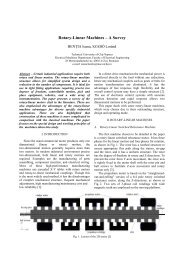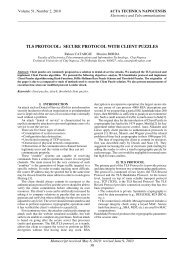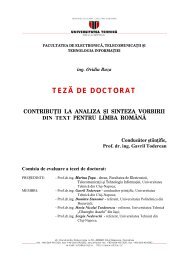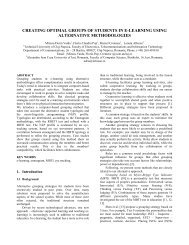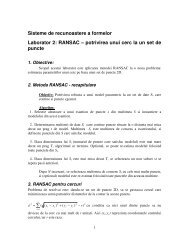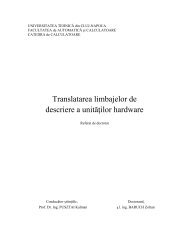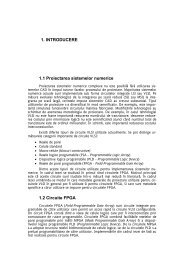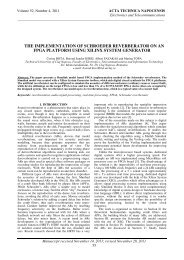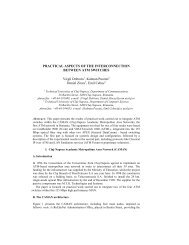LTE Emulator
LTE Emulator
LTE Emulator
You also want an ePaper? Increase the reach of your titles
YUMPU automatically turns print PDFs into web optimized ePapers that Google loves.
TUCN – Data Transmission Laboratory<br />
Frequency Position (BFP) principle, [Ste03], [Var05]. According to this principle, the<br />
scheduler uses the SNR levels predicted by each user for each chunk of the cell carrier<br />
(the predicted values are transmitted to the base station on the uplink channels) and<br />
allocates to the user the chunk or chunks which ensure the maximum possible values of<br />
the SNR. This approach ensures an instantaneous bit rate as close as possible to the bit<br />
rate imposed by the application and priority of the user – see the next paragraph. In this<br />
way, the chunk allocation algorithm considers both the radio channel quality of the<br />
considered user in the current TTI and the specific parameters of the application<br />
(required bit rate, priority).<br />
The operation required by the computation of the instantaneous bit rate/TTI and the<br />
OFDMA chunk allocation are performed sequentially for each user, a given user disposing at a<br />
certain moment only of the resources available after the resource allocation operations of the<br />
previous users. So, an ordering of the users is required, which is performed in the following way:<br />
o the users are grouped on service classes and inside each class they are placed in the<br />
descending order of the ratio between the desired instantaneous bit rate (see step three of<br />
the scheduler functioning principle) and the average bit rate of the application, dM; note<br />
that the ratio between this bit rate and the imposed average bit rate, dM is more important<br />
than the absolute value of the required bit rate. This procedure ensures a reasonable<br />
allocation of the resources (fairness) between users having services with the same<br />
priority, but with different bit rate requirements (for ex. an audio streaming and a video<br />
streaming);<br />
o the resource allocation is performed in the previously mentioned order. Those users who<br />
have higher priority and require higher instantaneous bit rate relative to the application<br />
average bit rate, are allocated first;<br />
o if it is not possible to allocate enough resources to some users, they will be allocated<br />
only the available resources, or it is possible not to be allocated at all. This will lead to a<br />
decrease of their computed average bit rate, and in the next TTI these users will “climb”<br />
in the allocation table and will get more radio resources (chunks with higher SNR or/and<br />
a greater number of chunks);<br />
o this algorithm requires the use of some buffers with appropriate dimensions in the base<br />
station, which should undertake the bit rate fluctuations and possible burstiness of the<br />
input data streams and ensure a continuous output stream with an average value equal to<br />
the average bit rate characteristic to the considered application;<br />
26<br />
5.2.2. Generation of the statistic tables. Table formats<br />
The types of the statistics associated to the emulated transmission, the format of tables with<br />
statistics and the generation algorithm of random variables distributed according to the imposed<br />
statistics constitute essential aspects of the emulation process. The number of statistics used and<br />
the table formats significantly influence the external memory capacity required by the emulator.<br />
The emulator uses two types of distributions, namely the distribution of data packets’ (IP packets<br />
or Ethernet MAC packets transmitted through the emulator) delays, and the distribution of errors<br />
which affect these packets.<br />
Regarding the delays of the data packets, the direct generation of these delays is not an<br />
optimal solution, because it would require an absolute or relative reference, relative to which the<br />
delays are measured. The use of the previous packet as a reference is not an acceptable solution<br />
because consecutive data packets applied to the emulator could be separated by random time<br />
intervals, which is characteristic to packet transmissions.<br />
An alternative better solution is to generate the instantaneous bit rate corresponding to the<br />
considered transmission, i.e. the generation of the instantaneous number of bits or bytes which<br />
are transferred in an imposed time period, corresponding to one TTI. This is the solution adopted<br />
in the present version of the emulator.



